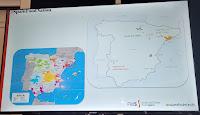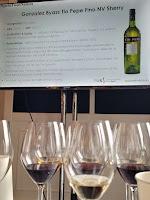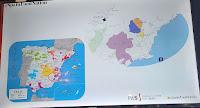 Last week I attended Spain's Great Match held at the Del Mar Restaurant located in The District Wharf. The day long event started with a Masterclass: Around Spain in 8 Glasses led by Master Sommelier Evan Goldstein & Advanced Sommelier Lindsey Fern. Why is Spanish viticulture important? Because Spain has the largest vineyard area of all the major vine-growing countries in the world and accounts for 13% of the World's vineyards. As a corollary, Spain is the third largest producer of wine globally and accounts for the 8th largest exporter to the U.S. by volume and 4th by value. Moreover, Spain is also home to over 400 individual grape varieties grown in over 70 D.O.s (Denominación de Origen) and two DOCas (Denominación de Origen Calificada) in Rioja and Priorat. The seminar focused on eight appellations through the eyes of one winery within each region.
Last week I attended Spain's Great Match held at the Del Mar Restaurant located in The District Wharf. The day long event started with a Masterclass: Around Spain in 8 Glasses led by Master Sommelier Evan Goldstein & Advanced Sommelier Lindsey Fern. Why is Spanish viticulture important? Because Spain has the largest vineyard area of all the major vine-growing countries in the world and accounts for 13% of the World's vineyards. As a corollary, Spain is the third largest producer of wine globally and accounts for the 8th largest exporter to the U.S. by volume and 4th by value. Moreover, Spain is also home to over 400 individual grape varieties grown in over 70 D.O.s (Denominación de Origen) and two DOCas (Denominación de Origen Calificada) in Rioja and Priorat. The seminar focused on eight appellations through the eyes of one winery within each region.  D.O. Cava
D.O. CavaThe Denominación de Origen was established in 1986 with 95% coming from within Penedès. The D.O. encompasses close to 94k acres of vineyard and over 6,100 growers. In 2022 the designation was more finely tuned with the creation of the Cava de Guarda (minimum of 9-months tirage) and Cava de Guarda Superior (minimum of 18-months tirage) designations. The leading grape varieties are Macabeo, Parellada, Xarel-lo, Chardonnay, and Pinot Noir. Our sparkling wine sample was the Parés Balta Blanca Cusiné Organic Cava 2014 ($52) which showcases the age-ability of Cava particularly after 80 months en tirage (secondary fermentation). The Xarel-lo heavy grapes were organically grown in central Penedès by the 3rd generation Cusiné family.
 D.O. Rías Baixas
D.O. Rías BaixasThis designation was created in 1988 and represents the cool and green northwest corner of Spain known as Galacia. It consists of five sub-regions with the Val do Salnés the historical focal point -- but each region is affected by the proximity to the Atlantic Ocean. Albariño is the dominant grape and there are rising trends for more barrel aging and sparkling programs. We have covered D.O. Rías Baixas very often in the past so please read these posts for more in depth coverage. The wine presented was an old friend, the Pazo Senorañs Colección Albariño 2020 ($25). The winery is located in the Val do Salnés and this wine shows the depth that Albariño is capable of showing particularly balanced with the racy minerality.

Established in 1989, Rueda is the oldest D.O. in Castilla y Leon and is located on high plains rising around 2,500 feet. The vines receive 2600 hours of sunshine annually and a large thermal diurnal change helping to maintain acidity and lengthen the growing season. Verdejo is the primarily grape and there are significant plantings of Sauvignon Blanc where a small percentage is often blended with Verdejo. The grape was considered a safety net in case Verdejo didn't flourish. Marques de Riscal pioneered this blend but we sampled the magnificent Marques de Riscal Organic Verdejo 2022 ($12.99) consisting solely of Verdejo. Lively tropical fruit.

This region was the second designation in Spain (1933) and is the southernmost wine region in Western Europe. It is known for sherry production and the white Albarizo (chalk) soils. This soil is poor in organic composition and highly porous but well suited for the Palomino Fino, Pedro Ximénez, and Moscatel grapes. In general sherry is produced when the grape must, called "yema", is fermented and fortified to 15.5% then enters a solera system where it is aged for various years. During this aging period, the wine undergoes biological aging under a layer of yeast called "flor". The Gonzales Byass Tio Pepe Fino NV Sherry ($22) is produced using this method and the unique pungent aromas from the flor blend nicely with the almond notes characteristic of the Palomino grape. Our visit to the winery is available here.

This was the first Spanish region to receive the D.O. status in 1925 and the first to receive the DOCa designation in 1991. The DOCa (Qualified Denomination of Origin in English) is the highest category in Spanish wine law, reserved for regions with above-average prices along with stringent quality controls. Rioja is the home of Tempranillo, the birthplace of the Spanish language, and consists of three zones: Rioja Alta, Rioja Alavesa, and Rioja Oriental. This is a hot Mediterranean climate influenced by high altitudes ranging from 1150 to 2100 feet. Besides Tempranillo, Viura, Malvasia Garnacha Blanca & Tinta, and Graciano are major players. We sampled the Finca Allende Rioja Tempranillo 2017 ($35) - a DOCa wine grown in Rioja Alta and naturally fermented and aged 14 months in Bordelais 225 liter barrels. Savory.

This designation was created back in 1966 and encompasses 61,755 acres located on a very high plateau (1,000 to 3,000 feet)) in southeastern Spain. The climate is hot and dry leading to abundant organic viticulture where the vines receive over 3,000 hours of sunshine a year. The soils are chalky and allows the vines to be planted ungrafted. Monastrell (Mourvèdre) is the signature grape and accounts for 77% of plantings. The grape was represented by the Juan Gil Silver Organic Monastrell 2021 ($18) - a certified organic wine made from 40+ year old vines. This is a delicious wine that I will be seeking for further sipping.

This designation was created in 2006 out of older designations and is completely encircled within DO Montsant. This is a high altitude region in Spain's northeast corner of Catalunya with a combination of Mediterranean and Continental influences. Soils are quartz and slate and known as llicorella. These conditions have lead to the "intense, full-bodied red wines; the classic Priorat wine is made from old-vine Garnacha and Samso/Cariñena, and has concentrated aromas of licorice, tar and brandied cherries". The Gratavinum 2pr Organic Priorat 2021 ($50) is a four grape blend dominated by Garnacha and then Carignan and is named after the Gratalops village in with the winery is located. There are twelve wine based villages within Priorat. There is surprising softness to the biodynamic farmed wine with a pleasant lingering finish.

Since its inception of a D.O. in 1982, this region has grown from 24 wineries to over 300 today but still one third of the vines are 45+ years old and 10% are 80+ years old. These vines consist of Viura, Malvasia, Garnacha Blanca & Tinto, Tempranillo, and Graciano. All excel in the string Continental climate featuring 40 degrees of diurnal temperature shifts -- partly due to the high altitudes (2,360 to 3,600 feet). The Pago de Anguix Costalara 2019 ($40) is made from 100% Tempranillo grown at 2,626 feet in elevation. Initial intensity leads to lush tannins.
